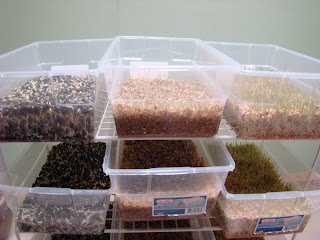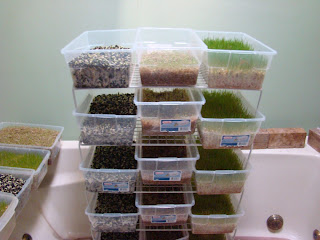I didn't forget about any of this, I've had a few other things to take care of on the farm and I thought this time I'd like to have more sequential pictures ready to post together.
This time I soaked the pasture mix & winter wheat for 8 hours, the black oil sunflower seeds for 2 hours and I added 1 Tbl of bleach to each 5 gallon bucket. I didn't mix the seeds/grains either. I filled each 5 gallon bucket 1/4 full with the seeds and then 1/2 full with water. I started soaking them in the morning, around 9am on the 13th.
I put 3.5 cups into each bin.
The winter wheat weighed 1 lb 12.6 oz wet.
The pasture mix weighed 2 lbs 1.2 oz wet.
The black oil sunflower seeds weighed 1 lb 8.4 oz wet.
Everything rinsed & set up to start round 2. The set up on the left is winter wheat, boss, winter wheat and pasture mix. In the bins on the racks its boss, pasture mix, winter wheat.
I made sure to use less in each bin, each being about 3/4 of an inch deep. (this will be lessened in round 3, you'll see why in the later pictures)
I also drilled tons more holes in the bins, along the bottom edges, up the sides about an inch and tons on the bottom for quicker draining.
1/13/13 - black oil sunflower seeds
1/13/13 - pasture mix (orchard, timothy, fescue & rye grasses with red & ladino clovers)
1/13/13 - winter wheat
I am amazed at how quickly the winter wheat responds to this process, these pictures were taken on the 13th, at night around 10, before I went to bed. I'd soaked them from 9am - 4pm, so that gave 6 hours of time between soaking & taking these pictures, look at the sprouting already starting!
1/14/13 - pasture mix - the clover has started sprouting - day 2
1/14/13 - winter wheat - more sprouting - day 2
No picture of the boss as it didn't show any changes.
I only rinsed twice instead of the 3 times. I've been using the flood method, filling the bins about 1/2 way so that the seeds are covered completely. I also keep the heater off in the master bathroom where I've got these set up. I talked with the guy at the feed mill and he reminded me that this is WINTER mixes, so they thrive in the cold. I think that adding the heat to the room may have contributed to the mold growth, as well as the over watering without having enough drainage holes.
1/15/13 - boss - let the sprouting begin! - day 3
1/15/13 - pasture mix - still just the clover sprouting - day 3
1/15/13 - winter wheat - check out the length on those sprouts! - day 3
1/16/13 - I didn't take pictures, one of the dogs was sick and we ended up at the vets picking up worm medicine. He is doing much better now :)
1/17/13 - boss - more growth and expansion - day 5
1/17/13 - pasture mix - the clover is turning green, the sprouts are very delicate and thin - day 5
I won't be using this mix again, not in sprouting anyways. Out in the fields its grows like wildfire, so that is where it'll get used.
1/17/13 - winter wheat - can you see how much the height has increased, not the grass, but in the level of wheat? The grass is a little over an inch tall - day 5
1/17/13 - on the racks - see how much the height level has increased? I started out with 3/4 of an inch in these bins. - day 5
1/18/13 - boss - they are starting to create a root mat, but the sprouts aren't really greening or getting much longer - day 6
1/18/13 - boss - root mat - day 6
1/18/13 - pasture mix - the clover has sprouted quite a bit, still delicate & thin, lots of green which isn't showing up well in the pictures (I think the chickens will enjoy this) - day 6
1/18/13 - pasture mix - roots - no grass sprouting/growth - day 6
1/18/13 - winter wheat - getting thicker and taller - day 6
1/18/13 - winter wheat - root mat - day 6
1/18/13 - racks - day 6
1/18/13 - additional bins - these bins also started out with 3/4 of an inch of seed in the bottom, the expansion has brought them to about 3/4 of an inch from the top of the bins! These bins have the most holes drilled in the bottoms and sides, so they are draining super quick. - day 6
1/18/13 - winter wheat - root mat - day 6
This bin is twice the size of the others and the walls are about twice as thick
1/19/13 - winter wheat - day 7
When I came in to water there were hundreds of water droplets on the blades, the blades are strong and thick
1/19/13 - water droplets close-up
1/19/13 - pasture mix - more green - day 7
1/19/13 - boss - starting to get some green - day 7
1/19/13 - racks - day 7
1/19/13 - at evening feeding I gave the chickens one of the boss bins and one of the pasture mix bins. They weren't quite sure about it initially, but then the turkeys started grabbing it and I guess they thought they were missing out so they started eating it, slowly.
I also took some to the goats. It took one sniff of the pasture mix and they were grabbing big mouthfuls! They didn't seem to care for the boss, but they love it dry, so maybe that will change.
The cows, horses & goats will get the winter wheat mats tomorrow. I'll take pictures of that and post.
Supplies price list:
Lowe's buckets - 3 - $2.78 each ($8.34) - already had on hand
Clear plastic storage tote - 22 - $1.00 each ($22.00) - already had on handMainstays Wire Stacking Shelves (long) - 5 - I bought these years ago in Mesa, AZ, at either Walmart, Kmart or Target, I honestly don't remember. I'm going to guess they were about $5.00 - $7.00 ($25.00)
1 100 lb bag winter wheat - $27.00 - already had on hand (purchased at local feed mill)
1 100 lb bag pasture mix - $145.00 - already had on hand (purchased at local feed mill)
1 50 lb bag black oil sunflower seeds - $23.99 - already had on hand (Tractor Supply on sale)


















































